The Air Force faces a daunting sustainment challenge with its legacy fighters. At a time when national strategy has changed and budgets are imploding, USAF must find a way to stretch the useful service lives of its older fighters, yet not invest too much in them because of their growing obsolescence against modern threats.
Despite fresh amputations of the Air Force fleet being debated in the Fiscal 2013 budget, the cornerstone of the combat air forces modernization plan remains largely untouched: the eventual purchase of 1,763 F-35A strike fighters. Delays in F-35 production due to test and development issues, however, are pushing the Air Force and Congress to consider the effect on the rest of the tactical fleet.

| ||
|
Amn. Basic Jonathan Sanchez (with laptop) coordinates with Amn. Dalvin Troublefield as they work on an F-15 at Sheppard AFB, Tex. (USAF photo by Frank Carter) |
While waiting for the F-35, the Navy and Air Force must still meet combatant commander needs for adequate numbers of strike fighters, a situation that compels service life extensions and upgrades on existing aircraft. Three of the Air Force’s four legacy fighter types will soon undergo structural durability testing, an intensive multiyear regime during which select F-16s, F-15Cs, and F-15Es will undergo what Air Combat Command’s Deputy Chief of Combat Aircraft Requirements Wayne C. Fisher calls a “shake and stretch” process. The testing involves stripping down a representative aircraft and putting it on an elaborate hydraulic rig that will bend, pull, and compress various parts of the airframes to simulate years of operations under various flight regimes. Sensors collect data on how the airframe bears up, which Air Force Materiel Command engineers will evaluate as the test progresses.
The structural testing should establish just how much life ACC can extract from these fighters in the coming years. The majority of the legacy combat fleet is approaching the original factory-warranteed number of flight hours, and the stress testing will be key to sorting out an efficient service life extension program, or SLEP, for them.
“If we have to fly our aircraft much longer, given their current age, we have to make sure they are structurally [sound],” said Fisher. While many of these platforms are creeping closer to the end of their originally projected life cycles (ranging from 8,000 flight hours to 10,000 hours), the planners expect them to “last as long as we need them into the future.”
The stress testing isn’t meant to uncover defects or flaws, but rather to certify engineering assumptions in order to keep some aircraft in service anywhere from 12,000 to 16,000 flight hours. Age Is Just a Number
“The expectation is … these aircraft are going to prove to have a service life that goes much beyond what they were initially intended to fly,” Fisher said.
The number of flight hours legacy aircraft have racked up varies significantly. According to ACC figures:
The oldest A-10 has around 9,000 equivalent flight hours, while the median aircraft in the fleet has flown just 7,000 hours.
For the F-15C fleet, the highest flight hour mark goes up to around 13,000 hours, while the median is 8,400.
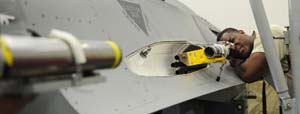
| ||
|
SSgt. Douglas Brown checks the alignment of an F-16 trainer aircraft’s M61A1 Vulcan cannon through a boresight telescope at Misawa AB, Japan. ( |
The “new” F-15E Strike Eagles, by comparison, have flown quite a bit in the last decade, with the highest-use aircraft in the fleet at 15,000 hours. The median is 9,000.
The so-called “pre-Block” F-16s—the Block 25s, 30s, and 32s—largely in the Air National Guard, have accumulated a median of 7,000 flight hours—not too far short of the highest-time aircraft, at 8,500.
USAF will have to track closely many factors as it tries to get more life out of its older combat fleet. The type of flying an aircraft does matters more than simply the number of hours it has accumulated, Fisher said. Some aircraft will fly 1,000 hours, but this may only equate to about 800 hours worth of stress on the aircraft. Causes can range from frequent deployments to structural wear—and this will be considered when the Air Force proceeds with its planned pre-SLEP stress testing.
The “F-16 SLEP is being designed right now,” Fisher said, and the results of the analysis and reporting from the stress testing at Ogden Air Logistics Complex at Hill AFB, Utah, will influence just what will be done to the Block 40 through Block 52 aircraft to safely extend their service lives. Stress testing will wrap up by Fiscal 2014 or 2015, he said. The first contract for SLEP kits is tentatively planned for early 2016, with follow-on kits in early 2017, and will comprise a depot-level upgrade. The first SLEP F-16s will join the fleet in 2017, with Combat Avionics Programmed Extension Suite (CAPES) aircraft coming the year after. While the engineering assumptions need to be validated for much of these older aircraft, Fisher maintains optimism—but notes that when it comes to sustaining aircraft, everything has a price.
“We have expectations, as old as they are, we will be able to keep our airplanes structurally sound far into the future, as long as we need them,” he said. “It’s not at no cost, but we can do it.”
A Hard Sell
With no change in plans, legacy aircraft retirements—beyond force structure cuts already announced—will begin around 2017 and accelerate into the early 2020s. The aircraft will retire faster only if F-35 procurement increases dramatically. No one anticipates that happening.
The size and relevance of the legacy CAF in the future force structure is still being debated. Most Air Force estimates show a shortfall of some 800 fighters by 2025 due to delays, retirements, and updated projections for beddown of the F-35.
“How do you evaluate risk?” asked Sen. Joseph I. Lieberman (I-Conn.), chairman of the Senate Armed Services airland subcommittee, in a May 18 hearing with USAF and Navy officials.
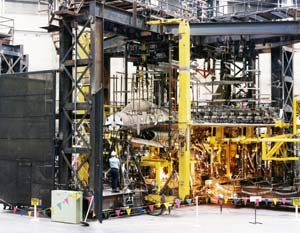
| ||
|
F-16s go through testing at a Lockheed Martin facility in Fort Worth, Tex. AFMC is performing tests on legacy fighters to determine how much longer they can stay in the fleet. ( |
The new defense strategic guidance emphasizes the ability of US forces to operate in anti-access, area-denial (A2/AD) environments, meaning adversary territory defended by the latest fighters, anti-aircraft systems, and electronic warfare. Consequently, almost all force planning scenarios for the CAF emphasize fifth generation assets that can overcome A2/AD and long-range strike aircraft able to penetrate heavy defenses from a distance.
Budget uncertainty beyond the five-year plan, however, dictates that whatever assets are retained in the inventory must be multipurpose, multimission platforms able to offer utility across a broad spectrum of conflicts. For that reason, modernizing the F-16 is getting a lot of attention.
In the posture statement accompanying its Fiscal 2013 budget proposal, Air Force leaders cited the “difficult choice” of divesting 227 additional aircraft from its combat and combat support fleets. For the CAF, this meant the total number of combat-coded fighter squadrons would dip from 60 to 54—31 active and 23 reserve component squadrons.
“As part of a broader strategy to reshape the Air Force into a smaller, yet capable, force, we divested 21 F-16 Block 30 aircraft in the reserve component and 102 A-10s … from the total aircraft inventory,” USAF leaders said in the statement.
That proposal is a hard sell with Congress, especially because USAF has already heavily cut its fighter force and is struggling with gaps in capability, exacerbated by the F-35 delays.
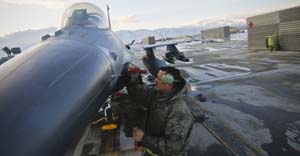
| ||
|
New Jersey Air National Guard crew chief SrA. Anthony Guddo inspects an F-16C at Bagram Airfield, Afghanistan. USAF is looking at performing a SLEP that will extend the service lives of a portion of the fleet. ( |
While some in Congress and even former USAF officials have suggested supplementing the force with new buys of fourth generation fighters, ACC boss Gen. G. Michael Hostage III has categorically rejected such a move. Any investment in brand-new fourth generation fighters “is just dumb,” Hostage said. Even if these new-old assets could be ordered immediately, it would take years to field them in effective numbers. That’s just about the time future threat planning scenarios project fourth gen types will no longer be able to survive the projected A2/AD threat.
Rather, USAF has stuck with a plan of reducing force structure in favor of a smaller number of highly capable assets. The retirement of 250 fighters in the last round of force structure cuts was meant to free up $3.5 billion so critical upgrade and munitions programs could be preserved. USAF reasoned that a smaller but high-quality force can keep USAF highly capable and credible. Air Force leaders have acknowledged, however, that numbers can only be drawn down so far, and the same aircraft can’t be in more than one place at a time.
Accepting Moderate Risk
The “CAF Redux,” as it was known at the time, also made available thousands of billets that could be shifted from fighter operation and maintenance to shorthanded specialties in the nuclear enterprise and intelligence, surveillance, and reconnaissance.
USAF readily admitted during the 2010 CAF Redux that the plan entailed “moderate” risk. The idea was that things would get better in the out-years. By the 2020s, it was argued, a larger portion of the fleet would be fifth generation assets. This calculus has not changed materially, at least pertaining to investment and sustainment of the CAF. USAF later pegged the fighter force structure at around 1,200 primary mission aircraft and 2,000 total airframes.
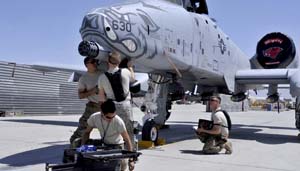
| ||
|
A maintenance crew from the 455th Expeditionary Aircraft Maintenance Squadron works on an A-10 at Bagram Airfield. A major upgrade just completed is to keep the A-10s flying into the 2030s. ( |
A shortfall of some three to five percent would persist through the Future Years Defense Program, Air Force leaders told Congress in 2011. Any capacity shortfall would be alleviated through improved F-35 production management, close monitoring of the health of the legacy CAF, SLEPs, and selective upgrades.
The new defense strategic guidance calls for more firepower than the legacy CAF can offer, however. According to DOD’s latest 30-year aircraft procurement plan, submitted with its Fiscal 2012 budget, “The age and capability limitations of manned legacy aircraft make them less valuable in the future—hence the department’s emphasis on fifth generation and unmanned aircraft.”
By Fiscal 2021, about a third of DOD’s manned fighter and attack aircraft will be fifth generation aircraft, embodying stealth, sensor fusion, and a high capability in electronic warfare. Only seven percent of the current force structure is fifth gen.
“Although the Air Force is downsizing, we must still provide the force structure and capability and be prepared to respond to a dynamic environment,” Air Force Secretary Michael B. Donley said in March.
At the May SASC subcommittee hearing, Lieberman asked, “How do we minimize risk in aircraft that we’re attempting to keep going longer than they were originally intended to?”
Lt. Gen. (now Gen.) Janet C. Wolfenbarger, then the military deputy in USAF’s acquisition shop and now head of AFMC, said the Air Force is looking at a “bridge capability” of dual approaches: a SLEP extending the F-16 fleet to about 10,000 hours and a suite of selective improvements, with avionics and other capabilities. The Fiscal 2013 budget request includes the F-16 stress and durability test and the CAPES, she noted. The F-16 CAPES will add active electronically scanned array (AESA) radar and new cockpit displays, along with data link enhancements and improved defensive suites.
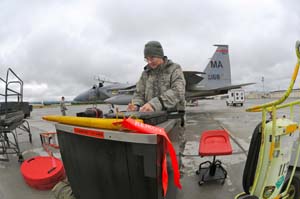
| ||
|
MSgt. Turner Fowks fills in maintenance information on an F-15 at JB Elmendorf-Richardson, Alaska. There are some 250 F-15C/Ds still in the fleet—about half with the ANG. ( |
For the remaining F-15 fleet—about 250 airframes, mostly in the Air National Guard—a program called the Eagle Passive/Active Warning Survivability System is now on the books. EPAWSS will replace the obsolete self-protection system, called the Tactical Electronic Warfare System (TEWS). Risk reduction and technology development for the new system will proceed in 2013, Fisher said. The F-15’s older electronic systems are rapidly becoming unsupportable and, along with the F-16 EW, upgrades will be installed in the field over the next seven to eight years.
“[That] brings a large portion of [both] our F-15E and -C fleet as well as a portion of our F-16 fleet to AESA capability,” Fisher said.
The F-15E fleet, slightly younger overall than the F-15C, will have AESA radars installed on all aircraft by the end of Fiscal 2013, said Brian Dillon, deputy program element monitor for the Strike Eagle at ACC headquarters. While the two aircraft have very different missions—the Strike Eagle is a multirole platform, while the F-15C is exclusively used for air superiority—the Air Force is trying to take advantage of their similarities.
The Pod Mod
The F-15Es and F-15Cs are a combined modernization program, as far as EPAWSS is concerned, Dillon noted. Moreover, the Air Force wants to develop a common solution for an Infrared Search and Track (IRST) system, which can be “podded” on either the Eagle or Strike Eagle. When developed, a new pod would be able to fast scan air-to-air threats, track targets, and get range data in the infrared spectrum.
“We are going to a common core processor for [the F-15]C and E,” Dillon said. Having different processors makes it difficult to develop a common pod, but once USAF develops a common code for them, it will open the door to a pod and other peripheral that can be fitted on both. The common processor is about “five to seven years down the road,” Dillon said.
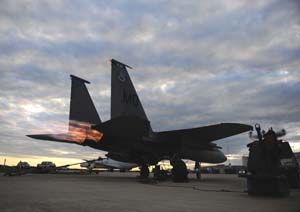
| ||
|
A maintainer conducts an afterburner test on an F-15E during Exercise Maple Leaf in Canada. The median flight hours for the younger F-15E fleet is 9,000. ( |
Due to the range of flight hours on the F-15E, ACC’s calculations will vary when it comes to modernizing certain pieces over time. Aircraft “that only have [4,000 or 5,000 flight hours] still have many years of service left,” Dillon said. For example, the Air Force may not have to buy 200 AESA radars if, in the next three or four years, 80 aircraft are selected for early retirement to the “Boneyard” at Davis-Monthan AFB, Ariz. This situation applies to a swath of the legacy CAF as well, especially as funding remains fluid and threat scenarios evolve.
“Fifteen years down the road, someone may come to us and say, ‘It’s no longer effective to put a new widget on a Strike Eagle,’ ” Dillon said. “But we’re nowhere near that point right now.”
The Air Force recently completed a major upgrade of the A-10C that can keep the fleet flying into the 2030s, but questions remain as to how much of the Warthog inventory will remain in service, due to budget pressures.
As the service trades “size for quality,” readiness and sustainment will be critical. So will programs such as the KC-46 tanker, space assets, and advanced ISR systems.
“Modernization remains a key concern, especially as our fleets age and new technologies drive new investment needs,” Donley said. As a result, in this budget—and likely going forward—modernization will be slowed to protect crucial future programs.

